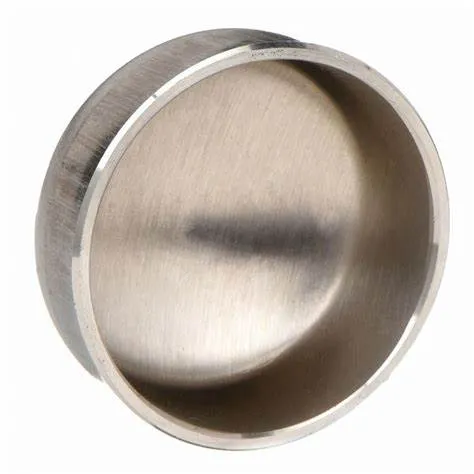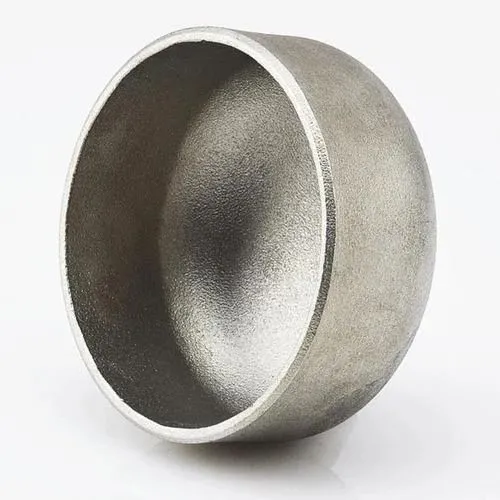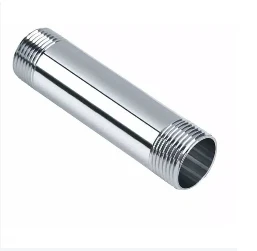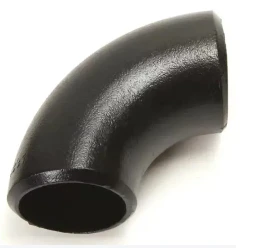JIS B2311 jẹ Apejuwe Ile-iṣẹ Ilu Japanese ti o ni wiwa awọn ohun elo paipu alurinmorin, pẹlu awọn fila ti a lo ninu awọn eto fifin. Awọn bọtini alurinmorin Butt ṣe idi ti pipade opin paipu kan, pese edidi kan lati yago fun jijo tabi idoti. Eyi jẹ ifihan si awọn bọtini alurinmorin apọju JIS B2311:
- 1. JIS B2311 Standard:
- Boṣewa JIS B2311 ṣalaye awọn ibeere fun apẹrẹ, awọn iwọn, awọn ohun elo, iṣelọpọ, ati idanwo awọn ohun elo alurinmorin, pẹlu awọn fila, ni awọn eto fifin.
- - Iwọnwọn ṣe idaniloju pe awọn bọtini ti a ṣe ni ibamu pẹlu awọn iṣedede JIS pade awọn iṣedede didara ati pe o ni ibamu pẹlu awọn paati fifin miiran.
- 2. Bọtini Alurinmorin:
- - Fila alurinmorin apọju, ni ibamu si JIS B2311, jẹ ibamu ti a ṣe apẹrẹ lati bo ati fi idi ipari paipu kan ni aabo, ti o funni ni aabo ati mimu iduroṣinṣin ti eto fifin.
- - A lo awọn fila ni awọn ipo nibiti opin paipu nilo pipade, boya titilai tabi fun igba diẹ, lati yago fun jijo, idoti, tabi lati pese ipari si eto naa.
- 3. Ohun elo ati Ikole:
- - Awọn bọtini alurinmorin Butt labẹ awọn alaye JIS B2311 wa ni ọpọlọpọ awọn ohun elo bii irin erogba, irin alagbara, ati irin alloy lati pade awọn ibeere ohun elo oriṣiriṣi.
- - Awọn bọtini wọnyi ni a ṣelọpọ nipa lilo awọn ọna ikole idiwon lati rii daju asopọ ti o lagbara ati ti ko jo nigba ti a fi wewe si opin paipu kan.
- 4. Ohun elo ati awọn anfani:
- - Awọn bọtini alurinmorin Butt wa awọn ohun elo ni ọpọlọpọ awọn ile-iṣẹ, pẹlu epo ati gaasi, awọn ilana kemikali, awọn ohun elo itọju omi, ati diẹ sii nibiti awọn ipari paipu nilo lati wa ni aabo ni aabo.
- - Awọn fila pese aabo si awọn opin paipu lati awọn eroja ayika, ṣe idiwọ ibajẹ, ati ṣe iranlọwọ lati ṣetọju mimọ ati iduroṣinṣin ti eto fifin.
- 5. Fifi sori ẹrọ ati Welding:
- - Awọn iṣe fifi sori ẹrọ ti o tọ, pẹlu titete to tọ, igbaradi ti ipari paipu, ati awọn imuposi alurinmorin, jẹ pataki nigbati o ba nfi awọn bọtini alurinmorin sori ẹrọ lati rii daju idii ti o muna ati jijo.
- - Alurinmorin jẹ ọna ti o wọpọ fun sisọ awọn fila si awọn paipu, pese aabo ati pipade titilai ti o le duro titẹ, awọn iyatọ iwọn otutu, ati ṣiṣan omi laarin eto naa.
- Ni akojọpọ, awọn bọtini alurinmorin apọju JIS B2311 jẹ awọn paati pataki ti a lo ninu awọn eto fifin lati di ati daabobo opin awọn paipu ni aabo. Awọn fila wọnyi ni ibamu si awọn ibeere idiwọn lati rii daju didara, igbẹkẹle, ati ibaramu laarin awọn ohun elo ile-iṣẹ nibiti pipade pipe ati aabo jẹ pataki.
What Is a Butt Welding Cap and How Is It Used in Industrial Piping?
In industrial piping systems, end-of-line sealing and branch closures require robust solutions. A butt welding cap serves as a critical component for terminating pipes securely. By providing a seamless, welded closure, this fitting maintains system integrity, prevents leaks, and supports compliance with industry standards.
What Is a Butt Welding Cap?
A butt welding cap—also called a pipe end cap or buttweld end cap—is a round fitting designed to close off the end of a pipe. It’s manufactured to match the pipe’s outer diameter and schedule, with either a hemispherical or flat face. To install, both the pipe end and cap are beveled to form a V‑groove, enabling full‑penetration, fusion welds. Common materials include carbon steel, stainless steel, nickel alloys, and other engineered grades, chosen to satisfy pressure, temperature, and corrosion‑resistance requirements.
How Is Butt Welding Cap Used in Industrial Piping?
Butt welding caps find application across oil & gas, petrochemical, power generation, water treatment, and general process industries for both permanent and temporary closures. During hydrostatic testing, technicians install caps to seal off sections of piping while monitoring for leaks. In new construction or retrofit projects, caps terminate branch lines, future tie‑in spools, or dead‑end mains until system expansion. Welders prepare each joint by cleaning and beveling surfaces, aligning the cap precisely, and executing a root pass followed by filler passes per the qualified Welding Procedure Specification (WPS). Post‑weld heat treatment and non‑destructive examination (NDE)—such as radiography or ultrasonic testing—verify weld integrity and compliance with ASME B16.9 and related standards. Additionally, temporary caps enable safe isolation during maintenance, allowing for segment testing and dewatering under regulatory protocols.
Benefits and Best Practices
Butt welding caps offer a smooth‑bore transition that minimizes flow disruption and stress concentration. Their full‑penetration welds deliver exceptional structural strength and leak resistance. To optimize performance, engineers should:
Select caps with matching material grades and wall thicknesses
Adhere to proper bevel angles and joint fit‑up tolerances
Follow qualified WPS protocols rigorously
Consider cladding or protective coatings in corrosive environments to extend service life
Regular inspection and thorough documentation ensure long‑term reliability and safe operation under demanding conditions.
Butt welding caps are indispensable components for achieving durable, leak‑proof pipe terminations in a wide range of industrial applications.
Butt Welding Cap FAQs
What is a butt welding cap?
|
What materials are commonly used?
|
What standards govern butt welding caps?
|
How are butt welding caps installed?
|
Where are butt welding caps typically used?
|
What are the advantages of threaded caps?
|
















